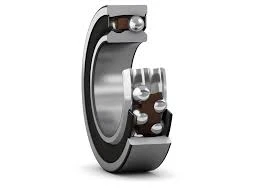
Nov . 13, 2024 18:04 Back to list
preloading angular contact bearings
Preloading Angular Contact Bearings An Essential Consideration in Mechanical Design
Angular contact bearings are widely utilized in various engineering applications due to their ability to support combined loads. Unlike standard radial bearings, these specialized bearings can withstand both axial and radial loads, making them ideal for high-speed applications where precise positioning and stability are crucial. However, to maximize their performance, proper preloading is a vital aspect that engineers and designers must consider.
Understanding Angular Contact Bearings
Angular contact bearings have raceways that are inclined to the axis of the bearing, which allows them to support axial loads in one direction and radial loads simultaneously. They are often used in pairs or sets to accommodate bidirectional axial loads and are available in various configurations, such as single-row or double-row configurations. The design of angular contact bearings is integral to their ability to achieve high-speed operation and provide stiffness, which is especially important in applications like machine tool spindles, automotive differentials, and aerospace systems.
What is Preloading?
Preloading refers to the process of applying a predetermined load to a bearing before it begins operation. This load compresses the bearing elements and minimizes play or clearance, thus enhancing rigidity and performance. In angular contact bearings, preloading is critical because it helps maintain consistent contact between the rolling elements and raceways. This consistent contact reduces the likelihood of vibration, misalignment, and premature wear, ultimately leading to a longer bearing lifespan and more reliable performance.
Benefits of Preloading Angular Contact Bearings
1. Increased Rigidity Preloading enhances the stiffness of the bearing assembly, which is essential for applications requiring high accuracy and load capacity. Increased rigidity minimizes deflections that could otherwise affect the operational precision of machines.
2. Improved Load Distribution By preloading the bearings, the load is distributed more evenly across the rolling elements. This balanced load distribution reduces stress concentrations and helps extend the fatigue life of the bearing.
3. Reduced Vibration and Noise Preloaded bearings operate with less clearance, which helps mitigate unwanted noise and vibrations. This is particularly important in precision machinery, where excessive vibrations can lead to inaccuracies and affect the overall quality of the product.
preloading angular contact bearings

4. Enhanced Stability Preloading provides greater resistance to axial displacement, enhancing the overall stability of the bearing arrangement. This is especially significant in high-speed applications, where stability is crucial for maintaining performance.
How to Achieve Preloading
Preloading can be accomplished through various methods, including
- Axial Load Application A constant axial load can be applied to the bearings using springs or spacers. This method allows for easy adjustments to achieve the desired preload level.
- Shim or Spacer Methods Using shims or spacers between the bearing and its housing can help achieve the required preload. This method offers accuracy and flexibility in adjusting the preload and is often used in assembly processes.
- Controlled Assembly Technique This involves carefully controlling the tightening torque applied to the bearing housing. A calculated assembly technique ensures the appropriate amount of preload is applied without over-tightening, which could lead to unnecessary wear or damage.
Conclusion
Preloading angular contact bearings is a fundamental consideration for engineers and designers aiming to optimize performance in their applications. By applying an appropriate preload, one can significantly enhance rigidity, improve load distribution, reduce noise and vibrations, and achieve greater overall stability. As industries continue to push the limits of performance in mechanical systems, recognizing the importance of preloading in angular contact bearings will remain critical for achieving efficient, reliable, and precise engineering solutions.
When selecting and implementing angular contact bearings in any mechanical system, understanding the principles of preloading not only ensures better performance but also contributes to the longevity and reliability of the machinery. Therefore, incorporating preloading strategies into the design phase should be a priority for those committed to excellence in mechanical engineering.
Latest news
-
Grooved Ball Bearing Design and Functionality
NewsJun.04,2025
-
Concrete Mixer Bearing Load Capacity Testing
NewsJun.04,2025
-
6004 Bearing Dimensions in Robotic Joint Designs
NewsJun.04,2025
-
Advantages of Single-Row Deep Groove Ball Bearings
NewsJun.04,2025
-
Applications of Deep Groove Ball Bearings in Automotive Systems
NewsJun.04,2025
-
Innovations in Bearing Pressing Machine Design
NewsJun.04,2025
